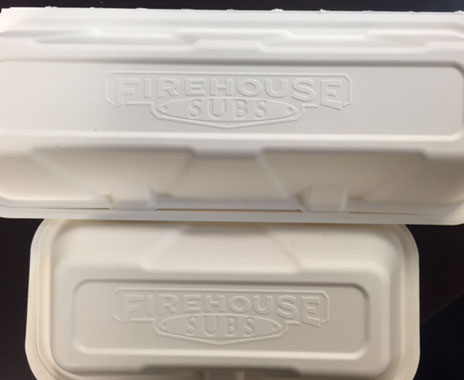Like many restaurant brands across America, Firehouse Subs witnessed a shift in traffic. Dine-in incidents declined as take-out business steadily rose.
This reality was turning out to be a frustrating one for the 1,088-unit chain. A staple in Firehouse’s DNA is its steamed meats and cheeses. Try wrapping those sandwiches in paper or foil, however, and the differentiator suddenly cuts the other way: The bread is soggy. Moisture builds up. “It’s just that it wasn’t as good as what we were serving in the dining room. In the dining room we don’t package the food at all,” says Don Fox, Firehouse’s CEO. “We serve the food plated in a basket. Great visual appearance. Every sandwich made and heated to order. That’s the ideal serving condition.”
About a year ago, Fox and the Firehouse team decided it was finally time to bridge the to-go gap. The chain completed its rollout last week of a new systemwide packaging lineup. It consists of three bagasse containers, which is an 100 percent compostable eco-friendly material made from the fiber mass of sugarcane. There’s one for Firehouse’s new smaller subs, one for medium sandwiches, and a container ideal for large orders. The containers are also microwaveable and heat tolerant up to 212 degrees, designed to handle hot food, grease, and be cut resistant.
If the product looks familiar, fans of the Firehouse Meatball have seen it before. It’s the same material Firehouse switched to in hopes of delivering its trademarked menu item in the past.
“From a green perspective, it’s an environmentalist’s dream. But the key benefit is it’s just excellent for the presentation of our product,” Fox says. “Far, far superior to anything we’ve done in recent years. We really feel we’re in the best position we’ve ever been to deliver an experience for our take-out customers that’s now on par with our dine-in experience.”
But unlike the meatball take-out change, this 100 percent move was the opposite of a quick swap. Fox says Firehouse had to find a manufacturer who could produce the vast quantity his growing chain needed. It required tooling at the plants and ramp-up time. Hence, the yearlong commitment.
“The manufacturing capacity out in the packaging universe was fairly limited,” Fox says. “… The logistical challenges were a little different because the cube size for shipping was a lot different than the wraps. It does add cost to the PNL but we feel it’s well worth the investment on the PNL to improve the guest experience on the off-premise consumption.”
Firehouse knew, from customer feedback, that there was a marked difference in guest satisfaction between in-house diners and those who took subs to go. That makes marketing the packaging change imperative, Fox says.
To start, Firehouse will let word-of-mouth fuel the message. Fox believes existing customers will spread the change quickly. He’s already seen it in action, in fact.
Fox was in South Florida recently for an industry conference when some regular customers, who are also industry suppliers, approached him and asked about the new containers.
“[They said it] gave them a much more premium quality experience,” Fox says. “Just the nature of the packaging itself uplifted, from their perspective, the value proposition. And obviously the experience is of a lot higher product quality than what they may have experienced before.”
Fox knows Firehouse will need to spread the message as well, especially when it comes to guests who may have written off the brand as a to-go option. He says Firehouse is still developing the creative, but it’s safe to say it’s coming, across traditional channels, social media, and more.
“It’s great rolling something out and the day that it hits the restaurant you’re getting benefit from it by virtue of the improved customer experience,” Fox says. “But the real goal is to capture back guests who may have ruled us out for to-go business in the past. Again, loved us for dine-in but ruled us out. So they’ve got to be told that there’s a change. They’re not going to stumble into it.”
Fox says the company really started to notice an uptick in to-go orders about four years ago, and it’s only accelerated since.
“We’re glad that we started this effort when we did. We had already noted the change in behavior but even since the initiation of the project it’s accelerated even more,” Fox says. “So it’s certainly good timing for us to be hitting the market with it.”









